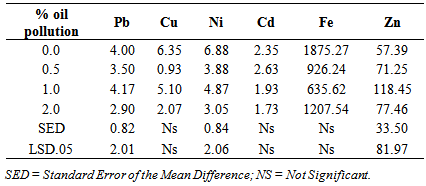-
Paper Information
- Paper Submission
-
Journal Information
- About This Journal
- Editorial Board
- Current Issue
- Archive
- Author Guidelines
- Contact Us
Resources and Environment
p-ISSN: 2163-2618 e-ISSN: 2163-2634
2014; 4(3): 173-179
doi:10.5923/j.re.20140403.06
Effect of Spent Lubricating Oil Pollution on Some Chemical Parameters and the Growth of Cowpeas (Vigna unguiculata Walpers)
Lale O. O.1, Ezekwe I. C.1, Lale N. E. S.2
1Department of Geography and Environmental Management, University of Port Harcourt, Nigeria
2Department of Crop and Soil, University of Port Harcourt, Nigeria
Correspondence to: Lale N. E. S., Department of Crop and Soil, University of Port Harcourt, Nigeria.
| Email: |  |
Copyright © 2014 Scientific & Academic Publishing. All Rights Reserved.
The effect of spent lubricating oil (SLO) pollution on soil nutrient and heavy metal content and growth of cowpeas (Vigna unguiculata Walpers) was investigated using potted plants in soils contaminated with different concentrations of SLO. The result showed that the concentration of SLO inhibited or significantly reduced plant height, laminar leaf area, number of leaves and shoot dry weight. Generally, the concentration of SLO had no significant effect on soil macro nutrients (N, P, K and magnesium) and concentrations of heavy metals (Cu, Ni, Pb) but they significantly increased the total hydrocarbon content of the soil. The treatments also had no significant effect on the soil physical properties (pH, % clay, % silt and % sand).
Keywords: Spent lubricating oil, Soil macro nutrients, Heavy metals, Soil physical properties, Cowpea
Cite this paper: Lale O. O., Ezekwe I. C., Lale N. E. S., Effect of Spent Lubricating Oil Pollution on Some Chemical Parameters and the Growth of Cowpeas (Vigna unguiculata Walpers), Resources and Environment, Vol. 4 No. 3, 2014, pp. 173-179. doi: 10.5923/j.re.20140403.06.
1. Introduction
- Disposal of spent lubricant into gutters, water drains, open plots and farms is a common practice especially by motor mechanics in Nigeria. This indiscriminate discharge of spent lubricating oil (SLO) is a major source of diffuse or non-point source of oil pollution to the environment. This creates a serious monitoring and control challenge as mechanic workshops and mechanic villages spring up everyday and everywhere without plan and policy for management of waste and protection of the environment.Engine oil is a blend of base oils (the non-volatile fraction of crude oil obtained by the vacuum distillation of crude oil) and performance enhancing additives. Crude oil is a complex mixture of thousands of hydrocarbons and non hydrocarbon compounds, including heavy metals. Although there is considerable variation between the ratios of organic molecules, the elemental composition of petroleum is well-defined. It is usually made up of Carbon (83 to 87%), Hydrogen (10 to 14%), Nitrogen (0.1 to 2%), Oxygen (0.05 to 1.5%), Sulphur (0.05 to 6.0%) and metals (< 0.1%). The most common metals are iron, nickel, copper and vanadium (Helmenstine, 2013). Although the toxicity of each individual component is known, the toxicity of complex mixtures such as crude oils and refined products is extremely difficult to assess; since the oil in an engine does more than just reduce friction between its moving parts it helps to seal the high- pressure combustion gases inside the cylinders to impede the corrosion of metal parts, absorb some of the harmful by-products of combustion, and transfer heat from one part of the engine to another. It usually contains additives such as amines, phenols, benzene, calcium, zinc, barium, magnesium, phosphorus, sulfur, and lead. The spent engine oil or lubricant is usually obtained after servicing and subsequent draining from automobile and generator engines. Nigeria alone accounts for more than 87 million liters of spent lubricant annually (Atuanya, 1987). Oil-contaminated soils are of environmental concern because they are unsuitable for agricultural and recreational uses and are potential sources of surface and ground water contamination. The Polycyclic aromatic hydrocarbon (PAHs) components of the oil have very low water solubility and often tightly bound to soil particles. Oil-polluted soil could also become unsuitable due to a reduction in the level of available plant nutrients or a rise to toxic levels of elements such as manganese. This heavy metal content of oil-contaminated soil imposes metabolic disorders and growth inhibition on most of the plant species. Some heavy metals are essential micronutrients for plant species. For instance, copper plays an important role in several plant metabolic processes. However, at excess of specific limits, these metals adversely affect plant growth (Ikhajiagbe et al, 2013)Soil contamination by oil hinders germination, reduces crop yield and also leads to premature death of plants (Udom et al., 2012). Oil makes the soil conditions unsatisfactory for plant growth, due to the reduction in the level of available plant nutrients or a rise in the amounts of certain elements such as iron and zinc to toxic levels. Stomatal damage, poor germination, and eventual death have been reported in several studies on plants grown in hydrocarbon polluted soils (Vwioko and Fashemi, 2005; Omosun et al., 2008). Omosun et al. (2008) also noted a progressive depression in the height, number of leaves and the leaf area of test plant (Amaranthus hybridus) with increase in the concentration of crude oil and they attributed these progressive depressions in physiologic conditions to a change in soil conditions. These changes imposed stressful conditions which interfered with water uptake and gaseous exchange. They suspected that this might have created a condition of physiological drought.Oil contaminated soil also causes delayed seed emergence although germination of seeds in oil polluted soil varied with different plant species. Inhibition in germination and seedling emergence of Solanum melongena, Ricinus communis and S. incarnum have been reported in waste oil polluted soils (Vwioko and Fashemi, 2005), while growth retardation was observed in Vigna seedlings. Growth inhibition in plants increased with increasing concentration of pollutants while growth reduction decreased after considerable amounts of soil pollutants would have been remediated by natural attenuation (Kayode et al., 2009; Ikhajiagbe, et al., 2013a). There are relatively large amounts of hydrocarbons in the used oil, including the highly toxic polycyclic aromatic hydrocarbons (Wang et al., 1996). Also, most heavy metals such as lead (Pb), aluminium (Al), nickel (Ni) and iron (Fe), which were below detection in unused lubricating oil, have been reported by Whisman et al. (1974) to give high values (ppm) in used oil. These heavy metals may be retained in soils in the form of oxides, hydroxides, carbonates, exchangeable cations, and/or bound to organic matter in the soil (Yeung, et al., 1992). Nevertheless, this is dependent on the local environmental conditions and on the kind of soil constituents present in the soil-water system. Ekundayo et al. (1989) have shown that a marked change in properties occurs in soils polluted with petroleum hydrocarbons, affecting the physical, chemical and microbiological properties of the soil. Oil pollution of soil leads to build up of essential organic carbon (C), phosphorus (P), calcium (Ca), and non-essential (magnesium (Mg), lead (Pb), zinc (Zn), iron (Fe), copper (Cu) elements in soil and the eventual translocation in plant tissues (Vwioko et al., 2006). This therefore poses high public health challenges as plant consumers are exposed to dangerous heavy metals.Although some heavy metals at low concentrations are essential micronutrients for plants, at high concentrations they may cause metabolic disorders and growth inhibition for most of the plant species (Fernandes and Henriques, 1991; Okonokhua et al., 2007). However, plants respond differently to pollutants. Anoliefo and Vwioko (1995) reported that the contamination of soil with spent engine oil caused growth retardation in plants, with the effect more adverse on tomato (Lycopersicon esculentum) than pepper (Capsicum annum L.).Oil pollution is becoming a major threat to food production in Nigeria and and this study investigated the influence of SLO on the yield parameters (under tropical conditions) of cowpea (Vigna unguiculata walp.) a major source of plant protein in West Africa. The effect of pollutants on macro and micro nutrients and the level of heavy metals in polluted soils were also investigated.
2. Materials and Methods
- The methods used in this study are methods described in Vwioko et al (2006). The seeds of cowpea (Vigna unguiculata Walp.), were purchased as a single batch from Choba Junction market in Port Harcourt city, Nigeria. The spent lubricating oil was obtained as pooled used engine oil from motor mechanics in one location in Port Harcourt city.The viable seeds (determined by floatation) were sown in soil (collected as a composite (pooled) sample of top soil (0 -20 cm depth), supplemented with water (control) and spent lubricating oil (crankcase oil) at different concentrations. Samples of soil of known weights (10kg) were treated with 0, 0.5, 1, 2, 4 and 6% w/w (weight of oil/weight of soil) spent lubricating oil (crankcase oil) and potted. Treatment of the soil was carried out gradually and by hand to get a homogenous mixture. Each soil sample was put in perforated 5-litre plastic pots and each treatment including control (0% SLO) was replicated three times. The pots were later transferred to the field. Each treatment including the control had 10 seeds of cowpea sown in them and water was added to all treatments as and when needed, to keep the soil moist. Ten viable seeds were sown in each pot at a depth of 3cm.Germination (%) records were taken at commencement of germination for up to10 days after sowing and seeds which failed to sprout after that time were regarded as dead. The height of plants was measured from the soil level to the flag leaf of the plant using a ruler. The laminar leaf area was determined and number of leaves counted. The plant height and leaf area were measured once a week for a period of 3 weeks.The samples were analysed for certain growth parameters as well as chemical parameters in course of this experiment.Plant Growth Parameters MeasuredGrowth parameters comprising germination percentage (%), plant height, laminar leaf area, number of leaves and shoot dry weights were determined in both treated and control soils and the results were compared in order to show the effect of SLO in soil on these growth parameters. Plant height was measured using a ruler and laminar leaf area was determined using the formula according to Pearcy et al. (1989). LA = 0.5 (Length x Breadth of leaf). The experiment was designed as a completely randomized one. One-way Analysis of variance (ANOVA) was carried out to compare the means of different treatments. Where significant F values were obtained, differences between individual means were tested using the LSD test.Plant Tissue Analysis:At harvest, the plants were carefully uprooted. The plant roots were gently ridden of soil particles. They were gently dipped in a bucket of water and rinsed twice with distilled water to remove attached soil particles. The plants were oven-dried at 80℃ for 3 days to obtain dry weights of root and stem. Oven-dried root, stem and leaf parts were ground using an electric powered blender (mill) to powder state. One gram (1g) samples of tissue were weighed into beakers and put in a muffle furnace for ashing at 550℃ for 5 hours. The ashed materials were allowed to cool. Ten milli-litre of 20% HNO3 were dispensed into each beaker containing the ashed samples. The mixture was warmed on a hot plate for 15mins and stirred with a glass rod to enable it to dissolve. After complete digestion, the solutions were allowed to cool, and made up to 50ml with distilled water. AAS measurements for metals were carried out.
3. Results
- Table 1 shows the concentration of the nutrients (Ca, K, Mg, and Mn) that were measured in the plants sown in control (0%) and in soils treated with various concentration of SLO. Calcium had higher values in treatments that had lower concentration of SLO than treatments with higher concentrations of SLO. Potassium also had higher values in treatments that had lower concentrations of SLO than those that had higher SLO concentration. However, potassium and calcium concentrations in plants declined with increase in concentrations of SLO. On the other hand, magnesium and manganese were not significant.
|
|
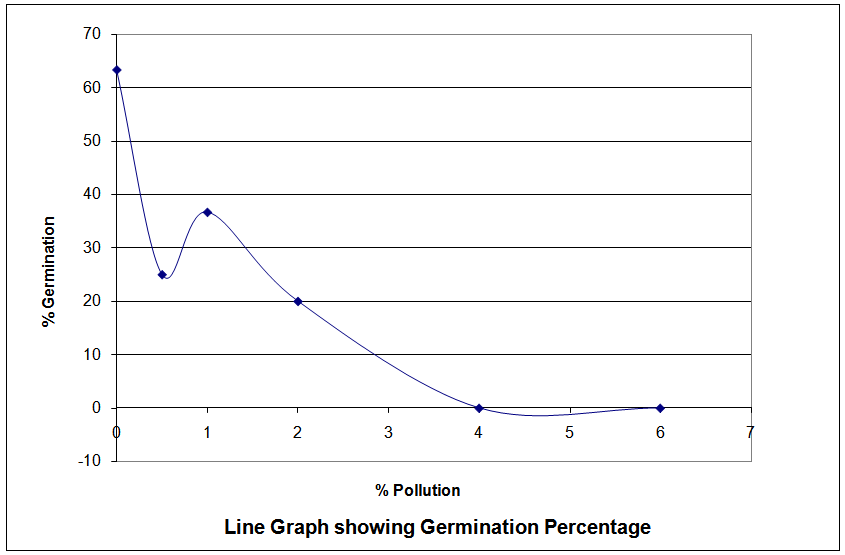 | Figure 1. The effect of spent oil polluted soil on germination of cowpea seeds |
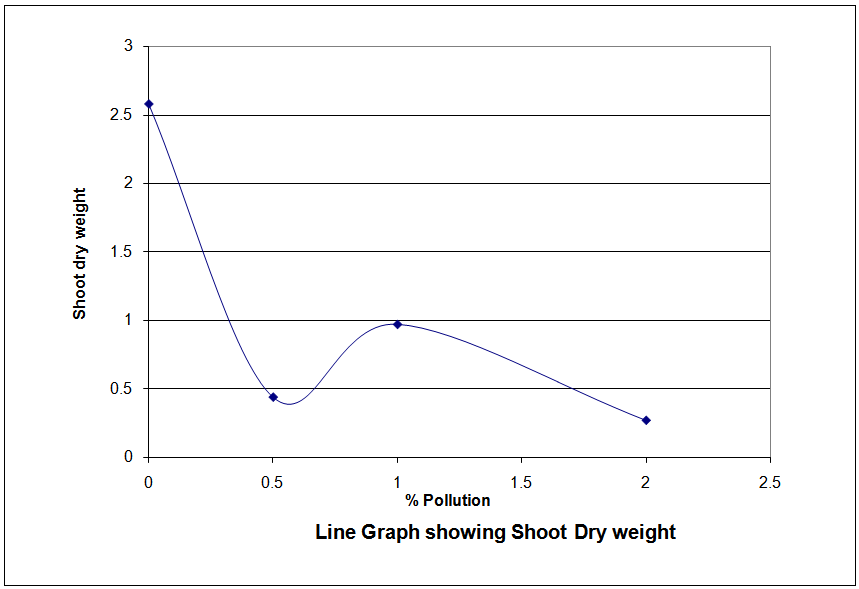 | Figure 2. Shoot (dry weight) of plants sown in soils contaminated with various concentrations of SLO |
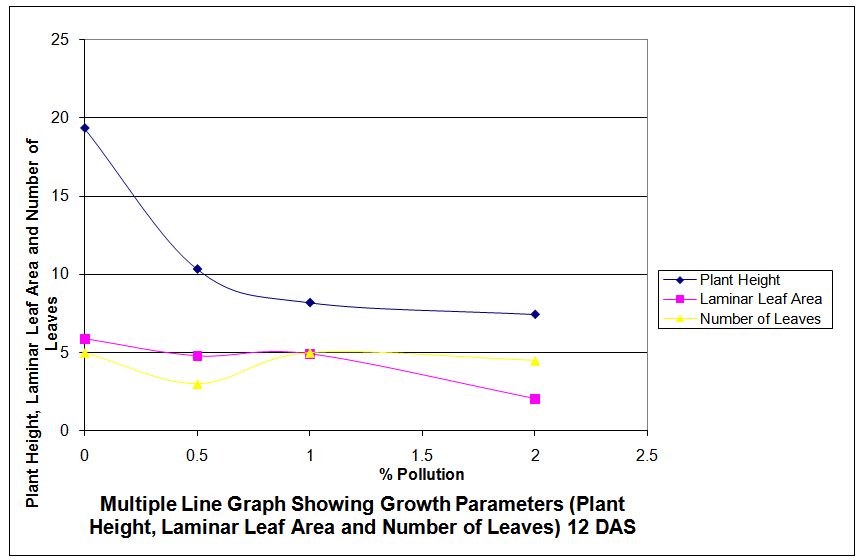 | Figure 3. Growth parameters (Plant Height, Laminar Leaf Area and Number of Leaves) of plants in treated soils after 12 days of sowing |
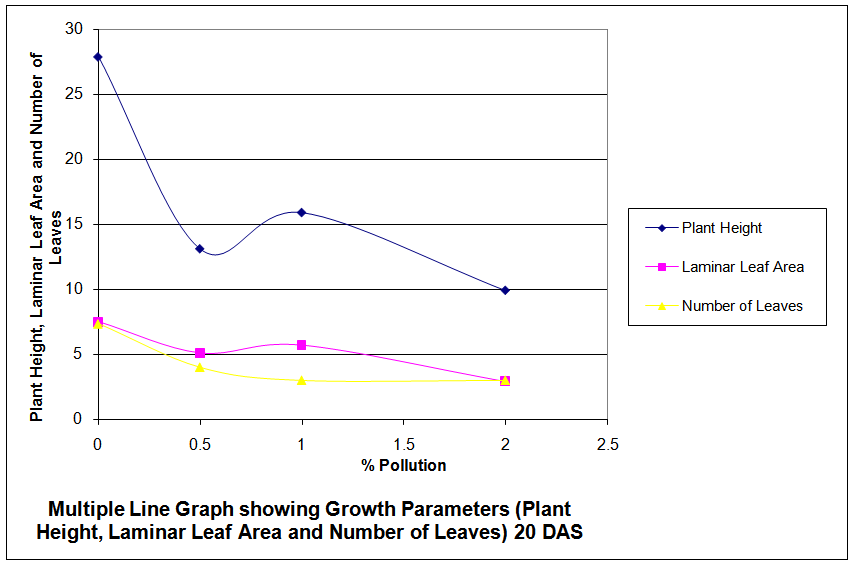 | Figure 4. Growth parameters (Plant Height, Laminar Leaf Area and Number of Leaves) of plants in treated soils after 20 days of sowing |
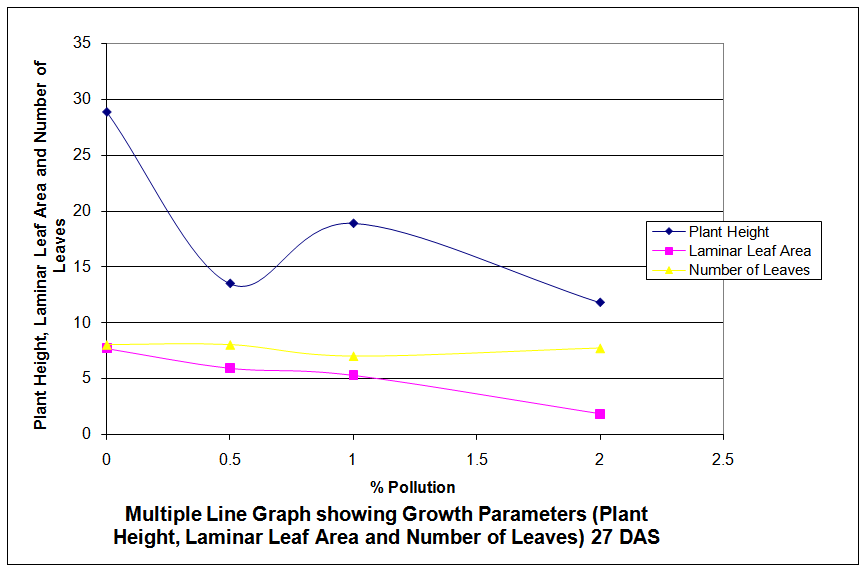 | Figure 5. Growth parameters (Plant Height, Laminar Leaf Area and Number of Leaves) of plants in treated soils after 27 days of sowing |
4. Discussion
- The presence of Spent Lubricating Oil (SLO) in soil generally resulted in delayed seed emergence and inhibited germination of seeds at higher concentrations. Seeds of cowpea began germination 3 Days after Sowing (DAS) in the control while no germination was recorded in any of the treatments 3DAS. Seeds of cowpea however began to germinate gradually in the lower treatments from 4DAS in 1% treated soils. No germination was recorded in the 4% and 6% treated soils throughout the experiment. A progressive decline in number of seeds that germinated with increase in SLO concentration was also observed. This delayed seed emergence, inhibition of germination and decrease in the number of germinated seeds with increase in SLO concentrations might be due to poor wetability and aeration of the soil. It might have also resulted from loss of seed viability. There is no adequate information regarding the precise mechanisms affecting the reduction in germination rate; however, there are several possible mechanisms suggested by various authors. According to Henner et al. (1999) some volatile fractions with less than 3 rings are found in spent oil. These compounds are known to have severe inhibitory impact on germination of several plant species. Another group of chemical compounds which are found abundantly in spent oil are polycyclic aromatic hydro carbons (PAHs) and has shown to have indirect secondary effects including disruption on plant – water – air relationships (Renault et al., 2000) and effects on soil microorganisms such as mycorrhizal fungi (Nicolotti et al., 1998). Vwioko et al. (2005) have suggested that in experiments exposing plant species to soil contaminated with various petroleum products, a reduction in germination rate could result from coating of oil on seed surface, thereby affecting physiological functions within the seed.It was observed in this study that the heavily polluted soils appeared darker in colour than the less polluted soils and darker soils absorb a lot of heat. This absorption of heat by the darker soils which are heavily polluted might have been what accounted for the inhibition of germination in the 4% and 6% treated soils.There was a progressive decline in plant growth parameters such as plant height, leaf area and number of leaves with increase in SLO concentration. This could be as a result of a change in soil parameters which imposed stressful conditions. These stress conditions might have interfered with water uptake and gaseous exchange resulting in a condition of physiological drought. It has long been established that soils contaminated with oil become waxy and usually does not allow water to penetrate from above (Adams et al,. 1960), and when wet, becomes water-logged. The waxy nature of the soil has been shown to contribute to a reduced oxygen content of the soil. This may be due to the blockage of pore spaces in the soil, thus causing stress on plants.
5. Conclusions
- This study has shown clearly the deleterious effects of SLO pollution on crop productivity which include growth and germination inhibition and reduction in other growth parameters. SLO pollution also interferes with the availability of micro and macro nutrients and increases the heavy metal content of soils, thereby posing a grievous public health challenge. The indiscriminate location of auto repair shops in Nigeria is therefore a real source of environmental pollution that threatens food security and the ecological integrity cum biodiversity within the vicinity of auto repair shops and other areas where SLO is disposed.
 Abstract
Abstract Reference
Reference Full-Text PDF
Full-Text PDF Full-text HTML
Full-text HTML
